Chapter 9
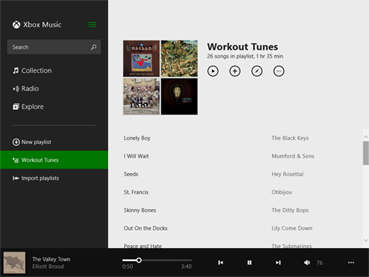
If you are into movies, TV shows, or music, you will appreciate the Windows apps that help you play, organize, edit, and generally get the most out of your multimedia. This chapter gives you the details on all of the Windows media apps.
Import Videos from a Digital Camera
Import Videos from a Digital Camera
You can import videos from a digital camera and save them on your computer. If your camera stores the videos on a memory card, you can also use a memory card reader attached to your PC to upload the digital videos from the removable drive that Windows sets up when you insert the card.
To perform the import directly from your digital camera, you need a cable to connect your camera to your PC. Most digital cameras come with a USB cable. After you have the digital videos on your system, you can view them.
Import Videos from a Digital Camera
 Plug in your camera or memory storage card reader.
Plug in your camera or memory storage card reader.
A notification appears.
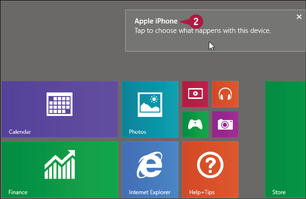
 Click the notification.
Click the notification.
Windows displays a list of actions that you can perform.
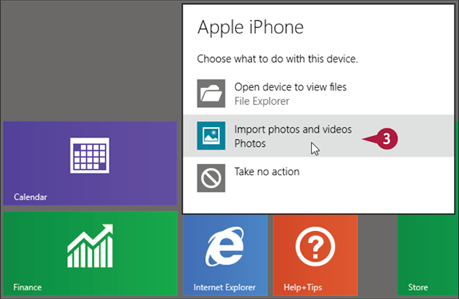
 Click Import photos and videos.
Click Import photos and videos.
The Photos app loads and displays the videos that are on your camera.
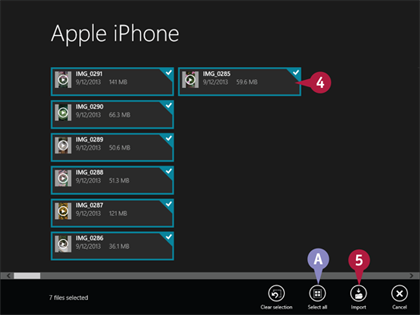
 Click each video that you want to import.
Click each video that you want to import.
A You can click Select all if you want to import all the videos.
 Click Import.
Click Import.
Windows imports the videos.
When the import is complete, the Photos app displays your imported videos.
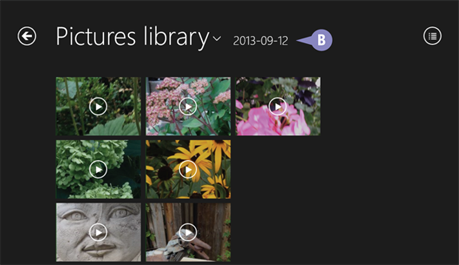
B The Photos app stores the imported photos in your Pictures library in a folder named after today's date.
Navigate the Videos Library
Before you can work with your videos, you need to locate them on your PC. You do that by using the Video app to open the Videos library, which is a special folder designed specifically for storing digital videos, movies, and TV shows.
To get more out of the Videos library, you need to know the basic techniques for opening any videos that you have stored in it. If you are looking for commercial movies or TV shows, you can also use the Video app to buy or rent a movie or to buy a TV show episode.
Navigate the Videos Library
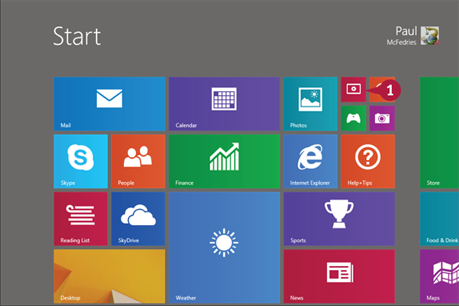
 On the Start screen, click Video.
On the Start screen, click Video.
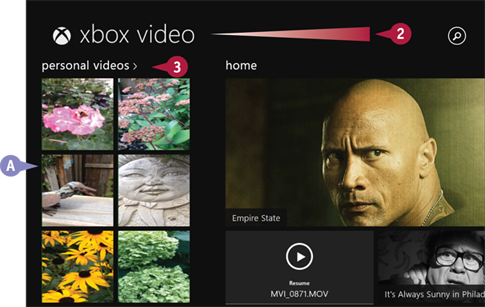
 Scroll left until you see the personal videos section.
Scroll left until you see the personal videos section.
A The Video app displays a selection of the videos on your PC.
 Click personal videos.
Click personal videos.
The Videos library appears.
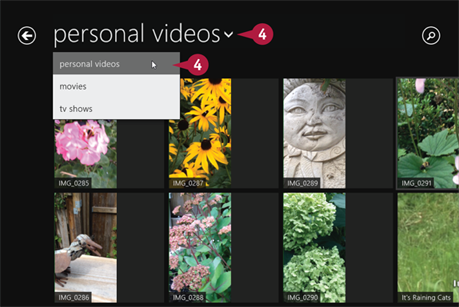
 Click the personal videos
Click the personal videos  and then select a video type.
and then select a video type.
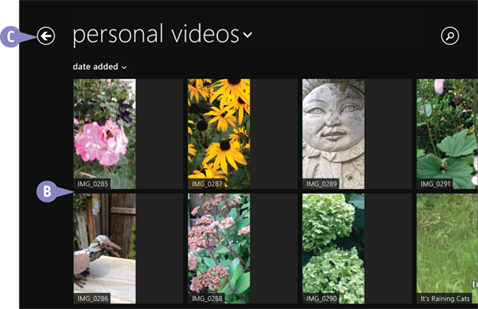
B The Video app displays the digital videos of that type that you have on your PC.
CYou can click Back ( ) to return to the previous section of the Video app.
) to return to the previous section of the Video app.
Watch a Video
After you know how to use the Video app to navigate your Videos library, you can use the app to select and play a video that you have on your PC. The Video app plays the video full screen on your PC, so you get the best viewing experience. When you have the video playing, you can pause and restart the playback, and you can use a special tool called the scrubber to quickly fast-forward or rewind the video to the spot that you want.
Watch a Video
Start a Video
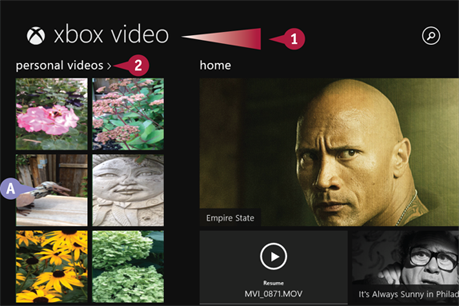
 In the Video app, scroll left until you see the personal videos section.
In the Video app, scroll left until you see the personal videos section.
A If you see the video that you want to watch, click it, and skip steps 2 and 3.
 Click personal videos.
Click personal videos.
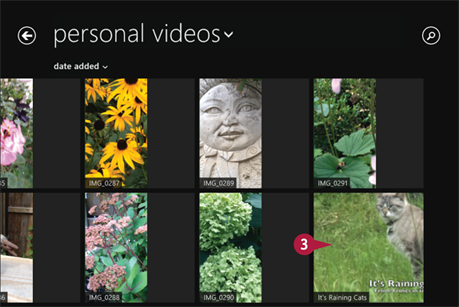
The Video app begins playing the video.
Control the Video Playback
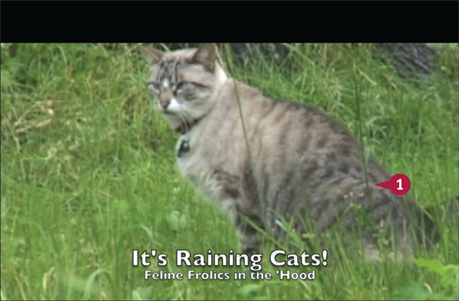
 Click the screen.
Click the screen.
The Video app displays the playback controls.
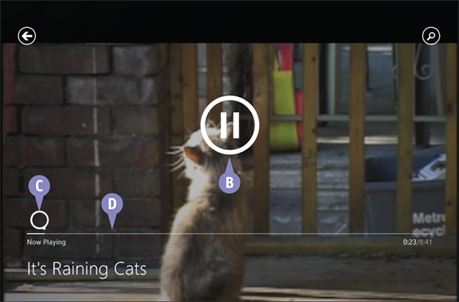
B Click the Pause button to stop and restart the playback.
C Click and drag the scrubber to rewind or fast-forward the video.
D Click the timeline to jump to that position in the video.
Play a Music CD
You can play music CDs in Windows Media Player. When you first insert an audio disc in your PC's optical drive (that is, a drive capable of reading CDs and DVDs), Windows asks what action you want to perform with audio CDs, and you can tell it to play them using Windows Media Player.
The CD appears in the Now Playing window. If you have an Internet connection, you will see the name of each track as well as other track data. You can control some playback options using the Now Playing window, but you can also switch to the Media Player library for more options.
Play a Music CD
Play a CD
 Insert a music CD into your computer's optical drive.
Insert a music CD into your computer's optical drive.
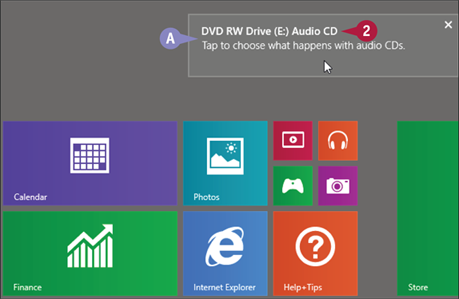
A Windows displays an audio CD notification.
 Click the notification.
Click the notification.
Windows displays a list of actions you can take when you insert an audio CD.
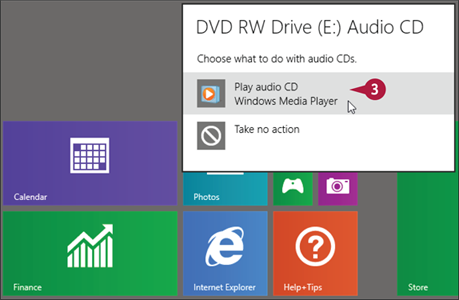
 Click Play audio CD.
Click Play audio CD.
The Windows Media Player Now Playing window appears and begins playing the audio CD.
Skip a Track
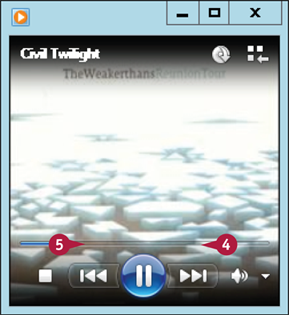
 Click Next (
Click Next ( ) to skip to the next track.
) to skip to the next track.
 Click Previous (
Click Previous ( ) to skip to the previous track.
) to skip to the previous track.
Pause and Resume Play
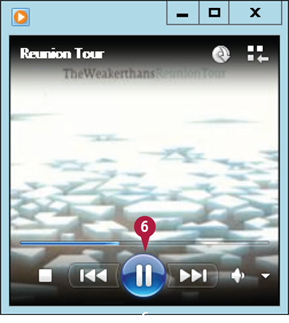
 Click Pause (
Click Pause ( ).
).
Windows Media Player pauses playback.
 Click Play (
Click Play ( ).
).
Windows Media Player resumes playback where you left off.
Play a Music CD (continued)
You can use the playback buttons at the bottom of the Windows Media Player library to control how a CD plays. For example, you can easily switch from one song to another on the CD. You can also use the Repeat feature to tell Windows Media Player to start the CD over from the beginning after it has finished playing the CD. Windows Media Player also offers the Shuffle feature, which plays the CD's tracks in random order. If you want to learn how to import music from the CD to Windows Media Player, see the section, “Copy Tracks from a Music CD.”
Play a Music CD (continued)
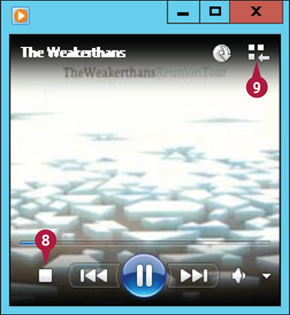
 Click Stop (
Click Stop ( ).
).
Windows Media Player stops playback.
If you click Play ( ) after clicking Stop (
) after clicking Stop ( ), the current song starts over again.
), the current song starts over again.
 Click Switch to Library (
Click Switch to Library ( ) to open the Windows Media Player library window.
) to open the Windows Media Player library window.
Play Another Song
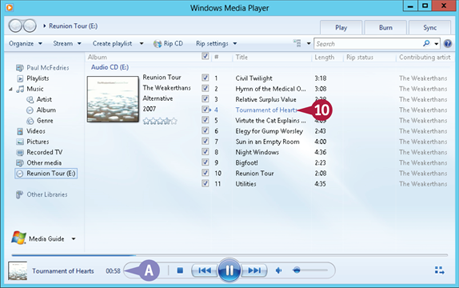
 In the details pane, double-click the song you want to play.
In the details pane, double-click the song you want to play.
Windows Media Player begins playing the song.
A This area displays the current song title, the album title, and the song composer (if one is listed).
Repeat the CD
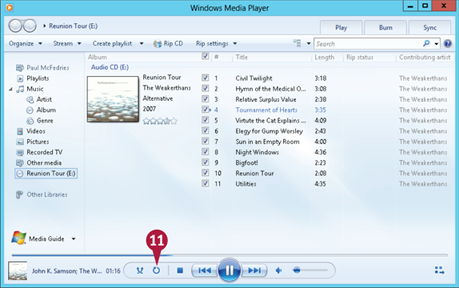
 Click Turn Repeat On (
Click Turn Repeat On ( ).
).
Windows Media Player restarts the CD after the last track finishes playing.
Note: To turn on Repeat from the Now Playing window, press  +
+ .
.
Play Songs Randomly
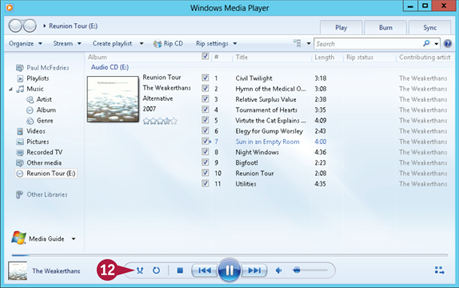
 Click Turn Shuffle On (
Click Turn Shuffle On ( ).
).
Windows Media Player shuffles the order of play.
Note: To turn on Shuffle from the Now Playing window, press  +
+ .
.
Copy Tracks from a Music CD
You can add tracks from a music CD to the library in Windows Media Player. This enables you to listen to an album without having to put the CD into your optical drive each time. The process of adding tracks from a CD is called copying, or ripping, in Windows.
You can either rip an entire CD directly from the Now Playing window, or rip selected tracks using the library. You can also use the tracks to create your own playlists and to create your own custom CDs.
Copy Tracks from a Music CD
Rip an Entire CD Using the Now Playing Window
 Insert a CD into your computer's optical drive.
Insert a CD into your computer's optical drive.
The Now Playing window appears.
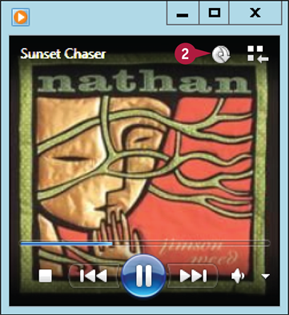
 Click Rip CD (
Click Rip CD ( ).
).
Windows Media Player begins ripping the entire CD.
Rip Selected Tracks Using the Library
 Insert a CD into your computer's optical drive.
Insert a CD into your computer's optical drive.
If the Now Playing window appears, click Switch to Library ( ).
).
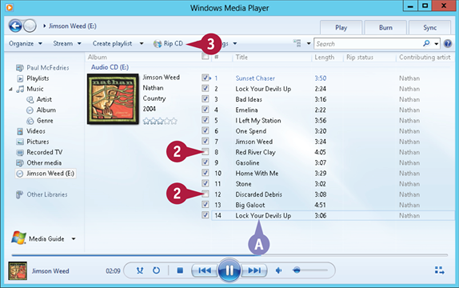
A Windows Media Player displays a list of the CD's tracks.
 Click the CD tracks that you do not want to copy (
Click the CD tracks that you do not want to copy ( changes to
changes to  ).
).
 Click Rip CD.
Click Rip CD.
Windows Media Player begins copying the track or tracks.
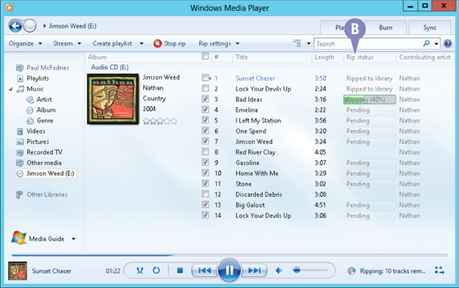
B The Rip Status column displays the copy progress.
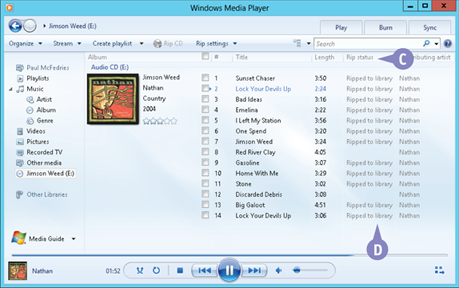
C After each file is copied, the Rip Status column displays a Ripped to library message.
D The copy is complete when all the tracks you selected display the Ripped to library status.
Navigate the Music Library
Before you can work with your songs and albums, you need to locate them on your PC. You do that by using the Music app to open the Windows Music library, which is a special folder designed specifically for storing digital music.
To get more out of the Music library, you need to know the basic techniques for opening any albums that you have stored in it. You can also use the Music app to purchase commercial albums or songs.
Navigate the Music Library
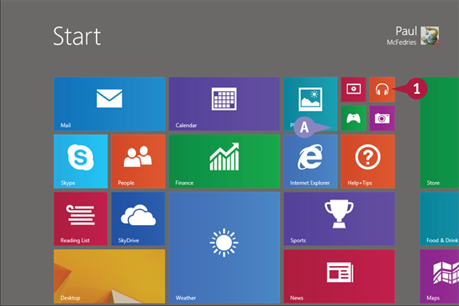
 On the Start screen, click Music.
On the Start screen, click Music.
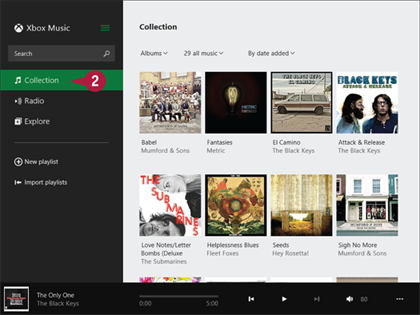
 Click Collection.
Click Collection.
The Music library appears.
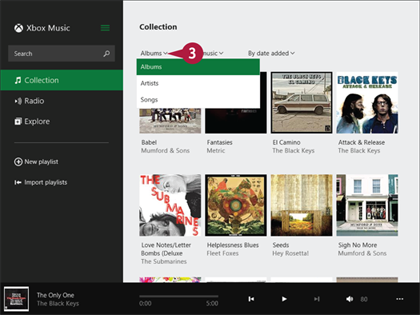
 Click the down arrow (
Click the down arrow ( ) and then click a music category.
) and then click a music category.
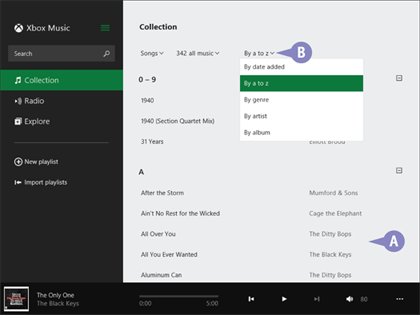
A The music in that category appears.
B You can click the down arrow ( ) and then click a sort order for the category.
) and then click a sort order for the category.
Play Music
If you want to listen to music while using your PC and your PC has either built-in or connected speakers, you can use the Music app to play tunes from your Music library. You can listen to all the songs on an album, all the songs from a particular artist, or individual songs.
The Music app offers several features for controlling the music playback. You can also play albums, artists, and songs in random order and play albums and artists repeatedly.
Play Music
Start Music
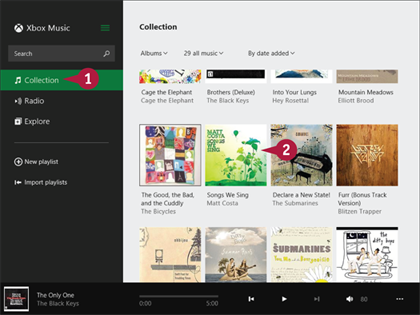
 Use the Music app to display your music.
Use the Music app to display your music.
Note: See the preceding section, “Navigate the Music Library,” for details.
 Click the item that contains the music you want to play.
Click the item that contains the music you want to play.
The Music app opens the item and displays a list of songs.
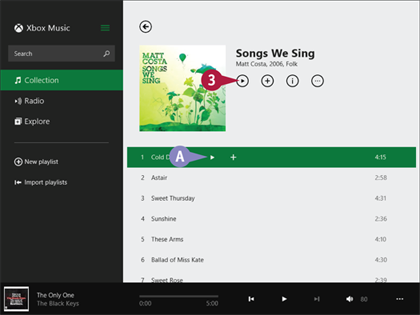
 Click Play (
Click Play ( ).
).
A You can also click a song and then click Play ( ).
).
Control the Music Playback
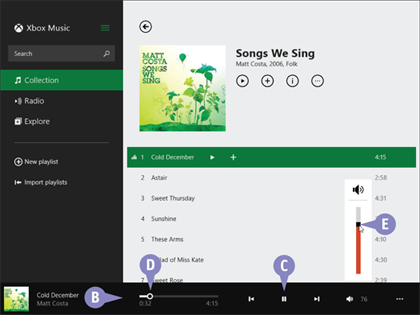
B When you play music, the Music app displays the playback controls.
C Click Pause ( ) to stop and restart the playback.
) to stop and restart the playback.
D Click and drag the scrubber to rewind or fast-forward the current song.
E To control the volume, click Volume ( ) and then click and drag the black square.
) and then click and drag the black square.
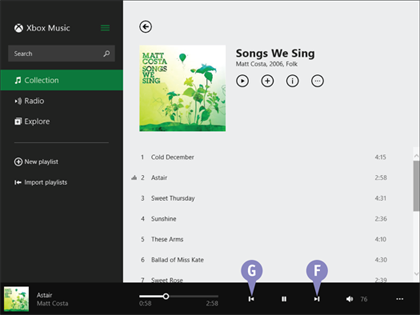
F Click Next ( ) to jump to the next song.
) to jump to the next song.
G Click Previous ( ) to return to the beginning of the current song. Click
) to return to the beginning of the current song. Click  again to jump to the previous song.
again to jump to the previous song.
Create a Playlist
A playlist is a collection of songs that represents a subset of your total music collection. A playlist can include audio tracks you ripped from a music CD, songs downloaded from the Internet, or music purchased through the Xbox Music Store.
You can use the Music app to create customized playlists that include only the songs you want to hear. For example, you might want to create a playlist of upbeat or festive songs to play during a party or celebration. Similarly, you might want to create a playlist of your current favorite songs to play during a workout.
Create a Playlist
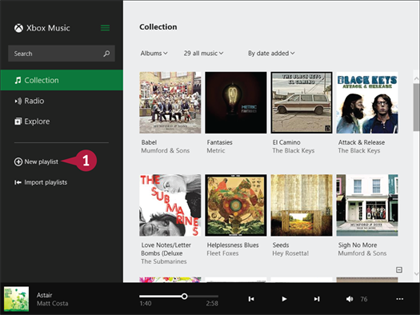
 Click New playlist.
Click New playlist.
Music prompts you to name the new playlist.
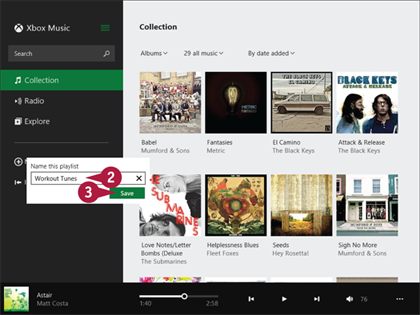
 Type a name for the new playlist.
Type a name for the new playlist.
 Click Save.
Click Save.
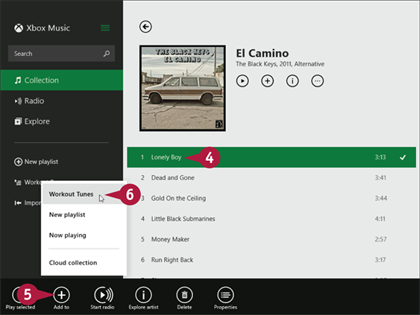
 Right-click a song that you want to add to the playlist.
Right-click a song that you want to add to the playlist.
 Click Add to.
Click Add to.
 Click the name of your playlist.
Click the name of your playlist.
Music adds the song to the playlist.
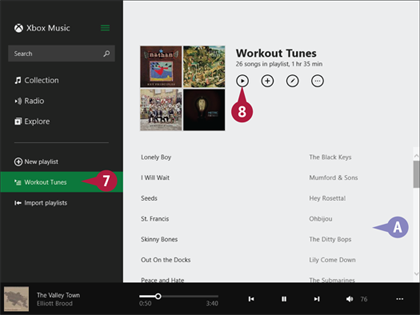
 Click the playlist.
Click the playlist.
A Music displays a list of the songs you added.
 Click Play (
Click Play ( ) to listen to the playlist.
) to listen to the playlist.
Create a Radio Station
To help you discover new music, you can create a radio station that plays songs that are similar to a particular artist, album, or song. That is, given a particular artist, album, or song, you can base a new radio station on that item, and Music plays a constant stream of songs that are similar.
The songs you hear come from the Xbox Music service, so you will likely hear many tunes and artists that you are not familiar with. If you like a particular song, you can buy it.
Create a Radio Station
Based on a Song
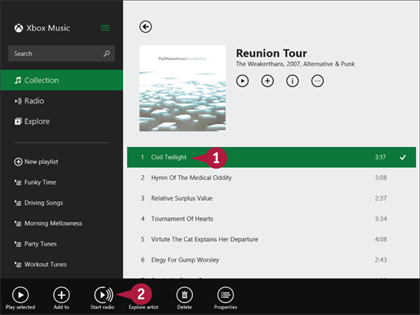
 Right-click the song you want to use as the basis of your radio station.
Right-click the song you want to use as the basis of your radio station.
 Click Start radio.
Click Start radio.
Music creates and begins playing the radio station.
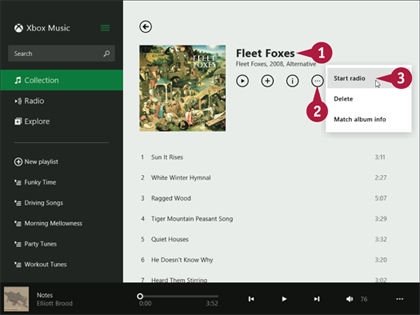
 Open the album you want to use as the basis of your radio station.
Open the album you want to use as the basis of your radio station.
 Click More (
Click More ( ).
).
 Click Start radio.
Click Start radio.
Music creates and begins playing the radio station.
Based on an Artist
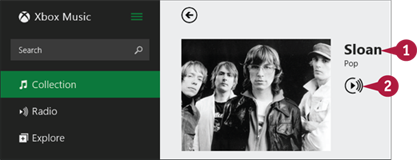
 Open the artist you want to use as the basis of your radio station.
Open the artist you want to use as the basis of your radio station.
 Click Start radio (
Click Start radio ( ).
).
Music creates and begins playing the radio station.
Based on Music in the Xbox Music Store
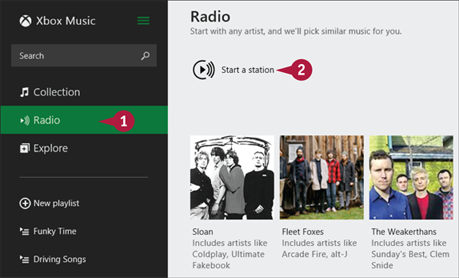
 Click Radio.
Click Radio.
 Click Start a station.
Click Start a station.
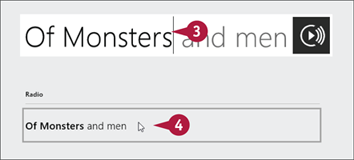
 Type the name of an artist.
Type the name of an artist.
 Click the artist.
Click the artist.
Music creates and begins playing the radio station.
 +
+ , click Preferences, click Choose where we look for videos on this PC, click Add (
, click Preferences, click Choose where we look for videos on this PC, click Add ( ), click SkyDrive, click This PC, and then click Pictures. Click the folder that Photos created when you imported your videos, click Add this folder to Videos, and then click OK.
), click SkyDrive, click This PC, and then click Pictures. Click the folder that Photos created when you imported your videos, click Add this folder to Videos, and then click OK. .
. ), and then click Repeat.
), and then click Repeat. ), type the new playlist name, and then click Save. To change the song order, right-click a song and then click either Move up or Move down. To delete a song from the playlist, right-click the song and then click Remove from playlist.
), type the new playlist name, and then click Save. To change the song order, right-click a song and then click either Move up or Move down. To delete a song from the playlist, right-click the song and then click Remove from playlist.